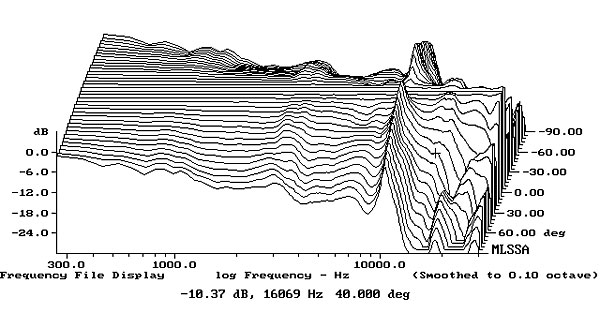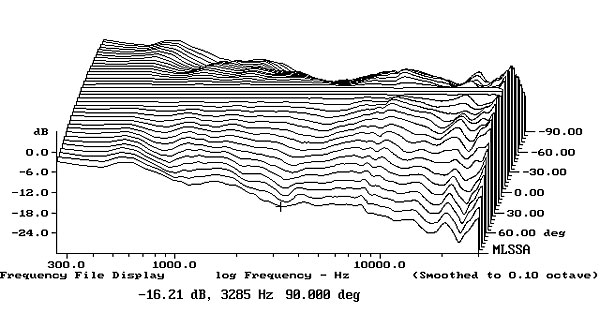Stereophile's JA said Excellent measured performance - Despite of limited bass extension and obviously high distortion below 200Hz and the odd lateral response around 10kHz.
This is most certainly a very interesting challenge for diyers, because the driver used obviously is openly available, unlike the one used in KEF LS50
Datasheet of H1602-04 H1602-04/06 L12RE/XFC

Stereophile measurements

Compare to KEF LS50 Anniversary

This is most certainly a very interesting challenge for diyers, because the driver used obviously is openly available, unlike the one used in KEF LS50
Datasheet of H1602-04 H1602-04/06 L12RE/XFC

Stereophile measurements

Compare to KEF LS50 Anniversary

Direct radiating two ways coaxials seems to be a defeated technology.
Um, no.
Your little bar graph is irrelevant, as there's not even a proposed correlation to audibility.
Stereophile's JA said Excellent measured performance - Despite of limited bass extension and obviously high distortion below 200Hz and the odd lateral response around 10kHz.[/URL]
The lateral response isn't odd, but a typical cancellation notch for round horns of that size. Stereophile normalizes those graphs to the axial response, so the axial cancellation notch appears as a big flare on their depiction of the lateral response.
The KEF "tangerine" phase plug does largely fix the issue.
Seas H 1602 (163,8 $) is a fine unit with an obvious advantage of being able to be put into a small cabinet. Otherwise you could do better for less money with Seas H 1152 (65,3 $) and Seas H 1280-06 (36,7 $).
Madisound has labeled H 1152 as 4,5" speaker (Sd=55cm2), and H 1602 as 5"( Sd=47 cm2), although these appear to have the same cone diameter and frame.
What's to be heard from a driver like this? The same as any other decent Seas unit with a little more HF diffraction issue due to tweeter being trapped like this. The sound is whatever you make of it, XO wise.
-------------------------------------------------------------------
The SEAS H1602 has smaller Sd because it has a larger voice coil diameter.
The L12 has better bass definition compared to a CA12RCY.
The integration between drivers in a coax system, specially at small distances is different compared to a non-coincident shceme.
4 years late to the party, but...
These speakers were my favorites at T.H.E. 2015. In answer to a question posed near the beginning of this thread, they're leagues above the KEF Q series. Mellower but somehow bigger-sounding than the LS50.
Still wondering if anyone has built a DIY version? Seas has their own recommendation for a box and their own schematics for a crossover.
These speakers were my favorites at T.H.E. 2015. In answer to a question posed near the beginning of this thread, they're leagues above the KEF Q series. Mellower but somehow bigger-sounding than the LS50.
Still wondering if anyone has built a DIY version? Seas has their own recommendation for a box and their own schematics for a crossover.
i have made 5 pcs with the bigger 6½" T18 in sealed box. Decent bass when positioned near the wall or in a bookshelf (or table as nearfield) I use them in HT setup with 2x15" subwoofer. Recommended! I have never seen or heard the smaller L12 coax.
SEAS Prestige T18REX/XFC (H1353) 7" Coaxial, clear Cone
SEAS Loki MkIII
SEAS Loki is bass-reflex, but one can use a bit smaller sealed box, when subwoofer is included in the system anyway.
SEAS Prestige T18REX/XFC (H1353) 7" Coaxial, clear Cone
SEAS Loki MkIII
SEAS Loki is bass-reflex, but one can use a bit smaller sealed box, when subwoofer is included in the system anyway.
My version is not Loki, but Finnish Audiokit AW-7, with alu tweeter. Xo is different as well. Xo tweaking is easy...
L/C/R speaker similarity is most important in HT systems - response and phase must match, to get good imaging and localization of sound.
Measured dispersion of my AW-7. On-axis looks nasty, but at 10-15deg response and LW is smooth as baby's butt!
L/C/R speaker similarity is most important in HT systems - response and phase must match, to get good imaging and localization of sound.
Measured dispersion of my AW-7. On-axis looks nasty, but at 10-15deg response and LW is smooth as baby's butt!
Attachments
Last edited:
Yes, I have made a speaker with these Seas Drivers. They sound amazing, large soundstage. In a small room they also make really good bass. Down to around 40hz. I am using a miniDsp at the moment but i want to make an analog crossover. Does anyone know if the XO in the application notes availabe for this driver is similar to the crossover for the SUN.
Sorry I'm late to the party but I've also made a pair, I got a chap on eBay who makes small single driver cabinets to make some boxes to the SEAS design document. Only cost around £100 so a good buy
I have to say that they sound astounding considering the size of the box. They aren't perfect, as you can't drive them stupidly loud but I'm getting good levels (not headbanger) in a 6m x 3.3m room. This is with a KT88 PP valve amp.
I finished them recently and attach a picture of them on top of my usual stand mounts. The camera angle makes them look bigger than they actually are.
I went for external crossovers as the cabinets are very small. The drivers are good enough to warrant foil inductors and Russian paper in wax capacitors. I went for the standard SEAS crossover implementation and (in my opinion) it sounds very good.
If you want maximum WAF in your life then they are well worth considering. I'm trying to go the other way and get some ESL57's into the living room, but these will do very nicely in my workshop.

I have to say that they sound astounding considering the size of the box. They aren't perfect, as you can't drive them stupidly loud but I'm getting good levels (not headbanger) in a 6m x 3.3m room. This is with a KT88 PP valve amp.
I finished them recently and attach a picture of them on top of my usual stand mounts. The camera angle makes them look bigger than they actually are.
I went for external crossovers as the cabinets are very small. The drivers are good enough to warrant foil inductors and Russian paper in wax capacitors. I went for the standard SEAS crossover implementation and (in my opinion) it sounds very good.
If you want maximum WAF in your life then they are well worth considering. I'm trying to go the other way and get some ESL57's into the living room, but these will do very nicely in my workshop.
Sorry I'm late to the party but I've also made a pair, I got a chap on eBay who makes small single driver cabinets to make some boxes to the SEAS design document. Only cost around £100 so a good buy
I have to say that they sound astounding considering the size of the box. They aren't perfect, as you can't drive them stupidly loud but I'm getting good levels (not headbanger) in a 6m x 3.3m room. This is with a KT88 PP valve amp.
I finished them recently and attach a picture of them on top of my usual stand mounts. The camera angle makes them look bigger than they actually are.
I went for external crossovers as the cabinets are very small. The drivers are good enough to warrant foil inductors and Russian paper in wax capacitors. I went for the standard SEAS crossover implementation and (in my opinion) it sounds very good.
If you want maximum WAF in your life then they are well worth considering. I'm trying to go the other way and get some ESL57's into the living room, but these will do very nicely in my workshop.
View attachment 1040066
What are the Seas coaxes sitting on? Those look like NHT C3s but in a new finish.
- Home
- Loudspeakers
- Multi-Way
- Trenner & Friedl Sun loudspeaker - clone ?


